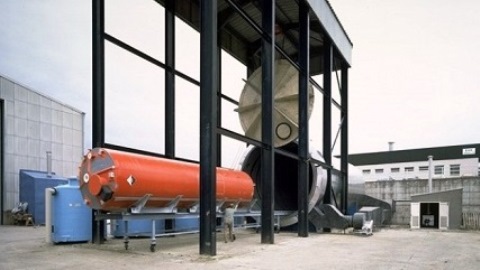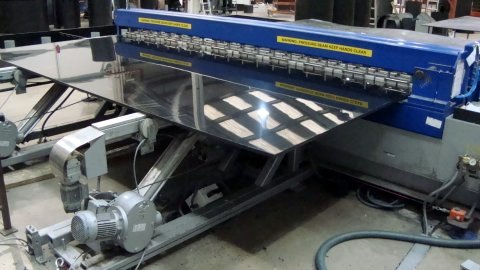Manufacturing Processes
Forbes have a vast collection of construction methods and machines in use, in order to maximise production efficiency, reduce costs and offer tanks of highest quality and suitability to each individual application.
The chop-hoop winding process combines all the advantages of computer controlled winding and spraying techniques, resulting in a considerable stronger laminate. The final laminate produced consists of 25% continuous rovings around the hoop, 25% multidirectional chopped glass fibre with 50% resin content.
Automated controls constantly monitor the rate of deposition of both glass fibre and resin and provide detailed quality records. The laminate is particularly strong and economical, producing a considerable multi directional strength. The continuous rovings applied around the cylinder produce an incredibly strong “belt” of fibres in the hoop load direction
Hoop chopped winding is the most efficient process for the production of both tank shells tanks & silos. Standard filament winding does not produce the ideal glass/resin ratio (50% glassfibre / 50% resin) for chemical process plant applications.
Hand laminated glass fibre laminates consist mainly of chopped strand mat glass fibre applied in sheets with resin onto a mould or the external surface of an inner thermoplastic corrosion barrier.
The resin is rolled into the glass fibre which is made up of chopped strands which are bonded together to form the sheet. The binder on the glass fibre is dissolved by the resin which then forms a very strong homogenous composite layer.
Continuous layers are applied until the required amount of glass fibre reinforcement is achieved.
Occasionally glass fibre woven rovings are applied in place of chopped strand mat which reduces the overall thickness.
Post-curing GRP tanks and vessels to achieve maximum performance from the laminates is referred to in the BS4994:1987. By linking any free styrene monomers and other organic residuals within the laminate, post-curing ensures optimum physical and chemical properties.
In highly aggressive applications, post-curing is essential to achieve the full chemical resistance. Without it, laminates can suffer from chemical degradation in certain environments and the risk of taint.
Forbes’ post-curing oven, fitted with a calibrated chart recorder, is over 5 metres in diameter and 13 metres long, allowing for the full immersion post-cure of even the largest of tanks. It is capable of sustaining temperatures in excess of 100° C over long periods.
Where necessary for process reasons, tanks will be post-cured in accordance with the resin manufacturer’s specifications to achieve optimum physical and chemical properties.
During 2013 Forbes invested in the latest automated CNC thermoplastic tank shell winding machine and its associated equipment. Tanks in excess of 100m3 capacity are designed & manufactured to BS EN 12573 and the very demanding German code DVS 2205.
The process involves two extruders which produce a continuous molten section of PE100 polyethylene or copolypropylene, which is helically wound on to a pre-heated steel mandrel, producing a seamless one piece shell. The mandrels vary in diameter up to 4m.
The process can produce tank shells up to 100mm thick and double wall tank shells, which form integrally bunded tanks known as Innatanks™. The machine can also produce tank shells with integral insulation.
To compliment this automated production, Forbes operate a CNC extrusion welding system to ensure the welds on the base and roof are of the highest possibly quality and accuracy.
Using a precision computer controlled butt welding machine, the two surfaces to be welded together are heated by a hot blade to a specific temperature, where the polymer becomes molten.
The two surfaces are then pushed together using a prescribed and uniform amount of force which is pre-determined by the computer.
Once cooled and the material has recrystallized an incredibly strong and homogenous welded joint is produced.
Such joints give in excess of 95% (often 100%) original sheet strength. Sheets up to 50mm thick can be joined in this way.
Manual welding is the long established method of welding using a hand held hot gas welding gun where 3 or 4mm diameter welding rod is fed into the joint.
This method requires much training and is only carried out by skilled personnel. Welders are fully trained, tested and certified to ensure high quality welds are applied at all times.
Regular testing takes place for all material handled.
Automated and hand weld extrusion welding processes produce a strong fillet weld in Polypropylene, HDPE and PVDF.






